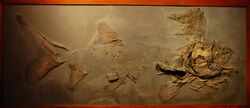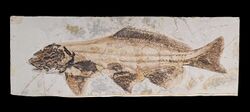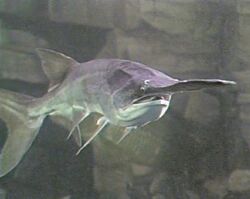Biology:Acipenseriformes
| Acipenseriformes | |
|---|---|

| |
| Atlantic sturgeon (Acipenser oxyrhynchus) | |

| |
| American paddlefish (Polyodon spathula) | |
| Scientific classification | |
| Domain: | Eukaryota |
| Kingdom: | Animalia |
| Phylum: | Chordata |
| Class: | Actinopterygii |
| Subclass: | Chondrostei |
| Order: | Acipenseriformes L. S. Berg, 1940 |
| Subgroups | |
| |





Acipenseriformes /æsɪˈpɛnsərɪfɔːrmiːz/ is an order of basal[1] ray-finned fishes that includes living and fossil sturgeons and paddlefishes (Acipenseroidei), as well as the extinct families Chondrosteidae and Peipiaosteidae.[2][3][4] They are the second earliest diverging group of living ray-finned fish after the bichirs. Despite being early diverging, they are highly derived, having only weakly ossified skeletons that are mostly made of cartilage, and in modern representatives highly modified skulls.[5]
Description
The axial skeleton of Acipenseriformes is only partially ossified, with the majority of the bones being replaced with cartilage. The notochord, usually only found in fish embryos, is unconstricted and retained throughout life.[6] The premaxilla and maxilla bones of the skull present in other vertebrates have been lost. While larvae and early juvenile Acipenseriformes have teeth, the adults are toothless, or nearly so. The infraorbital nerve is carried by a series of separate canals, rather than being within the circumorbital bones. The palatoquadrate bones of the skull possess a cartilaginous symphysis (joint), and also have a broad autopalatine plate, as well as a narrow palatoquadrate bridge, and a quadrate flange. The quadratojugal bone is three-pointed (triradiate), and the dentition on the gill-arch is confined to the upper part of the first arch and to only the first and second hypobranchials.[5] Members of Acipenseriformes retain the ability to sense electric fields (electroreception) using structures called ampullae. This ability was present in the last common ancestor of all living jawed fish, but was lost in the ancestor of neopterygian fish.[7] All Acipenseriformes probably possessed barbels like modern sturgeon (which have four) and paddlefish (which have two).[5]
Evolutionary history
Acipenseriformes are assumed to have evolved from a "palaeoniscoid" ancestor. Their closest relatives within the "palaeoniscoids" are uncertain and contested.[5] The last common ancestor of Acipenseriformes underwent a whole genome duplication event suggested to have occurred around 242–255 million years ago, with the genome subsequently undergoing rediploidization, both before the split between surgeons and paddlefish, and separately in both lineages after the split.[8]
Eochondrosteus from the Early Triassic of China has been suggested by some authors to be the oldest acipenseriform.[9] The oldest unambiguous members of the order are the Chondrosteidae, a group of large fish found in marine deposits from the Early Jurassic of Europe, which already have reduced ossification of the skeleton.[10] The Peipiaosteidae are known from Middle Jurassic-Early Cretaceous freshwater deposits in Asia.[11] The oldest known paddlefish is Protopsephurus from the Early Cretaceous of China,[12] while the earliest known sturgeons appear in the Late Cretaceous in North America and Asia.[13]
Classification
- Order Acipenseriformes Berg, 1940
- Genus †Eochondrosteus? Lu, Li & Yang, 2005
- Family †Chondrosteidae Egerton, 1858
- Genus †Chondrosteus Agassiz, 1833–1844
- Genus †Gyrosteus Agassiz, 1833–1844
- Genus †Strongylosteus Agassiz, 1833–1844
- Family †Peipiaosteidae Liu & Zhou, 1965
- Genus †Spherosteus Jakovlev, 1968
- Genus †Yanosteus Jin et al., 1995
- Genus †Liaosteus Lu, 1995
- Genus †Peipiaosteus Liu & Zhou, 1965
- Genus †Stichopterus Reis, 1909
- Suborder Acipenseroidei Grande & Bemis, 1991[14]
- Family Polyodontidae Bonaparte, 1838 (paddlefish)
- Genus †Protopsephurus Lu, 1994
- Genus †Paleopsephurus MacAlpin, 1941a
- Genus †Pugiopsephurus Hilton et al., 2023
- Genus †Parapsephurus Hilton et al., 2023
- Subfamily Polyodontinae Grande & Bemis, 1991 non Pflugfelder, 1934
- Genus †Crossopholis Cope, 1883
- Genus Polyodon Lacépède, 1797 (American paddlefish)
- Genus †Psephurus Günther, 1873 (Chinese paddlefish)
- Family Acipenseridae Bonaparte, 1831 sensu Bemis et al., 1997 (sturgeons)
- Genus †Boreiosturion Murray et al. 2023
- Genus †Protoscaphirhynchus Wilimovsky, 1956
- Genus † Engdahlichthys Murray et al. 2020
- Genus †Anchiacipenser Sato, Murray, Vernygora and Currie, 2019
- Genus †Priscosturion Grande & Hilton, 2009 [Psammorhynchus Grande & Hilton, 2006]
- Genus Acipenser Linnaeus, 1758
- Genus Huso J. F. Brandt & Ratzeburg, 1833
- Genus Scaphirhynchus Heckel, 1835
- Genus Pseudoscaphirhynchus Nikolskii, 1900
- Family Polyodontidae Bonaparte, 1838 (paddlefish)
Conservation
Most living species of Acipenseriformes are classified as threatened (mostly endangered or critically endangered) by the International Union for Conservation of Nature.
The Chinese paddlefish was last seen alive in 2003, and was considered to have gone extinct sometime between 2005 and 2010 by the Yangtze River Fisheries Research Institute in their 2019 report.
Hybridization
A study published in 2020 reported a successful hybridization between a Russian sturgeon (Acipenser gueldenstaedtii) and an American paddlefish (Polyodon spathula), indicating that the two species can breed with one another despite their lineages having been separated for hundreds of millions of years. This has marked the first successful hybridization between members of Acipenseridae and Polyodontidae.[15]
References
- ↑ Venkatesh, B. (December 2003). "Evolution and diversity of fish genomes". Current Opinion in Genetics & Development 13 (6): 588–592. doi:10.1016/j.gde.2003.09.001. PMID 14638319.
- ↑ Froese, Rainer, and Daniel Pauly, eds. (2006). "Acipenseriformes" in FishBase. 05 2006 version.
- ↑ Bemis, William E.; Findeis, Eric K.; Grande, Lance (1997). "An overview of Acipenseriformes". Environmental Biology of Fishes 48 (1–4): 25–71. doi:10.1023/A:1007370213924.
- ↑ Lu, Liwu; Tan, Kai; Wang, Xi (2020). "Redescription of Eochondrosteus sinensis (Acipenseriformes, Actinopterygii) and its geological age". Earth Science Frontiers 27 (6): 371–381. http://www.earthsciencefrontiers.net.cn/EN/abstract/abstract6009.shtml.
- ↑ 5.0 5.1 5.2 5.3 Bemis, William E.; Findeis, Eric K.; Grande, Lance (2002), Birstein, Vadim J.; Waldman, John R.; Bemis, William E., eds., "An overview of Acipenseriformes", Sturgeon Biodiversity and Conservation (Dordrecht: Kluwer Academic Publishers) 17: pp. 25–71, doi:10.1007/0-306-46854-9_4, ISBN 978-0-7923-4517-6, http://link.springer.com/10.1007/0-306-46854-9_4, retrieved 2022-07-27
- ↑ Leprévost, A.; Sire, J.-Y. (August 2014). "Architecture, mineralization and development of the axial skeleton in Acipenseriformes, and occurrences of axial anomalies in rearing conditions; can current knowledge in teleost fish help?". Journal of Applied Ichthyology 30 (4): 767–776. doi:10.1111/jai.12525.
- ↑ Crampton, William G. R. (July 2019). "Electroreception, electrogenesis and electric signal evolution". Journal of Fish Biology 95 (1): 92–134. doi:10.1111/jfb.13922. ISSN 0022-1112. PMID 30729523.
- ↑ Redmond, Anthony K.; Casey, Dearbhaile; Gundappa, Manu Kumar; Macqueen, Daniel J.; McLysaght, Aoife (2023-05-19). "Independent rediploidization masks shared whole genome duplication in the sturgeon-paddlefish ancestor". Nature Communications 14 (1): 2879. doi:10.1038/s41467-023-38714-z. ISSN 2041-1723. https://www.nature.com/articles/s41467-023-38714-z.
- ↑ Lu, Liwu; Tan, Kai; Wang, Xi (2020). "Redescription of Eochondrosteus sinensis (Acipenseriformes, Actinopterygii) and its geological age" (in zh). Earth Science Frontiers 27 (6): 371–381. http://www.earthsciencefrontiers.net.cn/EN/abstract/abstract6009.shtml.
- ↑ Hilton, Eric J.; Forey, Peter L. (December 2009). "Redescription of † Chondrosteus acipenseroides Egerton, 1858 (Acipenseriformes, †Chondrosteidae) from the lower Lias of Lyme Regis (Dorset, England), with comments on the early evolution of sturgeons and paddlefishes". Journal of Systematic Palaeontology 7 (4): 427–453. doi:10.1017/S1477201909002740. ISSN 1477-2019. http://www.tandfonline.com/doi/abs/10.1017/S1477201909002740.
- ↑ Hilton, Eric J.; Grande, Lance; Jin, Fan (2020-10-08). "Redescription of †Yanosteus longidorsalis Jin et al., (Chondrostei, Acipenseriformes, †Peipiaosteidae) from the Early Cretaceous of China". Journal of Paleontology 95 (1): 170–183. doi:10.1017/jpa.2020.80. ISSN 0022-3360. http://dx.doi.org/10.1017/jpa.2020.80.
- ↑ Grande, Lance; Jin, Fan; Yabumoto, Yoshitaka; Bemis, William E. (2002-07-08). [0209:PLAWPP2.0.CO;2 "Protopsephurus liui, a well-preserved primitive paddlefish (Acipenseriformes: Polyodontidae) from the Lower Cretaceous of China"]. Journal of Vertebrate Paleontology 22 (2): 209–237. doi:10.1671/0272-4634(2002)022[0209:PLAWPP2.0.CO;2]. ISSN 0272-4634. https://doi.org/10.1671/0272-4634(2002)022[0209:PLAWPP]2.0.CO;2.
- ↑ Sato, Hiroki; Murray, Alison M.; Vernygora, Oksana; Currie, Philip J. (2018-07-04). "A rare, articulated sturgeon (Chondrostei: Acipenseriformes) from the Upper Cretaceous of Dinosaur Provincial Park, Alberta, Canada". Journal of Vertebrate Paleontology 38 (4): (1)–(15). doi:10.1080/02724634.2018.1488137. ISSN 0272-4634. https://www.tandfonline.com/doi/full/10.1080/02724634.2018.1488137.
- ↑ Grande, L.; Bemis, W.E. (1996). "Interrelationships of Acipenseriformes, with Comments on 'Chondrostei'". Interrelationships of Fishes. San Diego, California: Academic Press. pp. 85–115. doi:10.1016/B978-012670950-6/50006-0. ISBN 0-12-670950-5. OCLC 34990143. https://books.google.com/books?id=H20q9rqZENsC&pg=PA112.
- ↑ Káldy, Jenő; Mozsár, Attila; Fazekas, Gyöngyvér; Farkas, Móni; Fazekas, Dorottya Lilla; Fazekas, Georgina Lea; Goda, Katalin; Gyöngy, Zsuzsanna et al. (July 2020). "Hybridization of Russian Sturgeon (Acipenser gueldenstaedtii, Brandt and Ratzeberg, 1833) and American Paddlefish (Polyodon spathula, Walbaum 1792) and Evaluation of Their Progeny". Genes 11 (7): 753. doi:10.3390/genes11070753. PMID 32640744.
- Martin Hochleithner and Joern Gessner, The Sturgeons and Paddlefishes of the World: Biology and Aquaculture
- Martin Hochleithner, Joern Gessner, and Sergej Podushka, The Bibliography of Acipenseriformes
- Sepkoski, Jack (2002). "A compendium of fossil marine animal genera". Bulletins of American Paleontology 364: 560. http://strata.ummp.lsa.umich.edu/jack/showgenera.php?taxon=611&rank=class. Retrieved 2011-05-17.
External links
Wikidata ☰ Q192422 entry
 |


